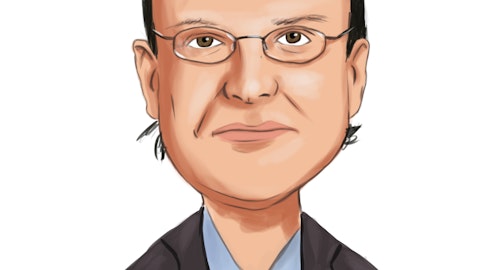Operator: Our next question comes from Joseph Giordano from Cowen.
Unidentified Analyst : Good morning. This is Michael on for Joe.
Ron Keating: Hey, Michael
Ben Stas: Hey, Michael
Unidentified Analyst: I just wanted to touch briefly. Again, I know this was mentioned earlier on the call, but with revenue growth expectations for next year. It seems a little higher than most were expecting. So kind of paring this back, how much of this would be like classified as new type business? And how does that work in terms of segmentation? Does ISS grow a little faster due to the backlog? And does APT’s decelerate at all?
Ben Stas: You should see a relatively balanced growth next year. Both segments have very strong backlog. A lot of it depends on what happens in the macro. And as the year develops, ISS is sitting, if you notice on page 10. You see that capital backlog has increased, and it’s ramped up over the — and have a little higher mix of capital, that will convert over a shorter period of time, if you just look at the conversion rates on that chart. So ISS is well positioned from that standpoint. And APT is seeing an all-time record backlog as well. So both segments have great opportunities as we head into the future.
Unidentified Analyst: Thanks. That’s helpful. And one more follow-up, if I may. On the drinking water side, it appears, it’s kind of a second quarter of consecutive neutral outlook. What are some, kind of, expectations for next year? And what are some drivers for that business as well?
Ron Keating: I mean if you think about municipal drinking water, that a lot of the investment that’s going to come there is going to be around PFAS. That’s also going to be around some of the treatment systems that are flowing down from the government funds that are coming. We expect that those will be coming in the latter half of 2023 into 2024 and 2025 as the bunch flow.
Unidentified Analyst: Okay. Thank you.
Operator: Our next question comes from Brian Lee from Goldman Sachs.
Brian Lee: Hey, guys. Good morning. Thanks for taking the questions.
Ron Keating: Hey, Brian.
Ben Stas: Hey, Brian.
Brian Lee: Hey. Maybe just kind of zooming out of it on the margin question here. I know it sounds like then, Ron, you’re embedding some conservatism as per the usual into the guidance. But this would be kind of the third straight year where you’re hanging around the 17% plus or minus EBITDA margin range. You, obviously, have talked about a longer-term target to get to 20% or so. So can you kind of give us a sense of what you need to see, not necessarily in 2023, but just kind of moving forward for that trend line to kind of start putting back on track to that long-term target, whether it’s supply chain, price, mix? Just trying to get a sense of when we might start to see some of that inflection towards drawing that out?
Ron Keating: Yes, Brian, it’s a great question. And, as we know, the last couple of years have not been overly normal years. We’ve been dealing with COVID and then runaway inflation. I think we’ve focused very heavily on being disciplined and offsetting our cost increases or price. Now, it’s time for us to get the spread. So this year, we’re being pretty balanced in it looking forward and not knowing what kind of economic pullback may occur. And really what’s going to happen, as Ben highlighted earlier with a lot of the diesel fuel, a lot of freight challenges that we dealt with. But what I would say is our price is very sticky. As we roll price increases, it’s not something that is going to go up and then be pulled back. We’ll roll it forward.
We see a little bit of an abatement in inflation. We’ll start to see the spread happen. And we think that that’s going to occur certainly over time. We’ve become very disciplined in our pricing actions in the way that we go forward and the way that we quote jobs now. And I think we will start to see in the latter half of this year, assuming things €“ things start to abate on the inflationary side and into 2024 and 2025, I think you’ll see us getting back on track to achieving that 20% EBITDA margin we’re focused on.
Brian Lee: Okay. That’s great. Appreciate the color. And then just talking about the back half since you did call out the potential for slowing. Again, I know you’re trying to embed some conservatism given the uncertainty that exists in the economic environment. Where do you potentially see that arising? It sounds like it’d be on the capital spending front, but are there specific end markets or geos where you’re thinking the slowdown could arise? And then just kind of the implications for mix, I mean, it almost dovetails with the comments you just made about margins maybe the latter half starting to get back on track. Maybe that’s a comment on mix as well. But just any thoughts there on the second half commentary.
A €“ Ron Keating: Yes. I think it really — you go back to our Page 5 that we pointed out, you can see the diversification of our end markets. And a lot of these end markets are fairly resilient to different types of recessions. I mean obviously, Life Sciences is going to continue to be robust. Microelectronics look like they’re going to continue to be robust, certainly with the CHIPS Act and some of the onshoring or near-shoring that’s occurring right now. The one that we really watch is like general industry, which is on the upper right-hand side of the page. It’s a fairly good market for us. That’s one that we think if we do see a slowing, we will see it come there first, and it will come in capital projects. But we think that the benefit of us having approximately 60% of our full revenue be sticky, steady recurring service and aftermarket.
Everyone’s going to continue to run their water systems. They just may not be investing as strongly in capacity expansion or new capital and light in general, would be where we’ll see it first.
Brian Lee: Okay. Thanks a lot, guys.
Operator: The next question comes from Patrick Baumann from JPMorgan.
Patrick Baumann: Hi, good morning. Thanks for taking my questions. Just wondering if you could give us some more color on the magnitude of pricing increases you’re seeing in terms of revenue contribution, both in the fourth quarter and kind of where it landed for 2022? And then what are the expectations for price into your fiscal 2023? And then just kind of along those lines, you talked about the process by which you’re pushing price in the services business in particular and whether you’ve seen any attrition as a result of pushing price as those contracts come up for renewal?
Ben Stas: Sure. So, this quarter, we saw about an 85/15 split price to volume. Next year, we’re expecting to see price to volume be in that 60/40 range. We’ve highlighted that in the appendix for you on our assumptions, so more volume. And we are not seeing much attrition at all. The price has been very sticky and stable, and we continue to push it. I think the good news is we’re seeing that price to become accretive to margin in Q4, which is one of the areas that we wanted to really push for. So, the key for us now is in margin expansion, as Ron mentioned earlier, is just getting our labor productivity improvement as we onboard the service tax and our plant employees. And so we feel good about being able to work that margin expansion. But overall, we do expect to see a little more volume in next year as we liquidate that very strong backlog and continue to focus on driving revenue through backlog.
Ron Keating: And on our pricing on our service contracts, our service contracts are annual contracts, there’s no single month that they all start and stop. So, it’s a rolling 12 months. We’ve been able to roll price increases into those. We have not seen a tremendous amount of attrition from it. In fact, it’s — we’ve stayed very strong. And I would say, over time, and we’ve grown in our service business, as you can see on our backlog chart. Throughout COVID, we really rerated with our customer base that they knew that we were there to serve them, to take care of them. And we set a standard that the customer expects to see and to achieve and they’re willing to compensate us for.
Ben Stas: And I make sure I correct that we’re going to be 60% volume, 40% price next year, okay?




